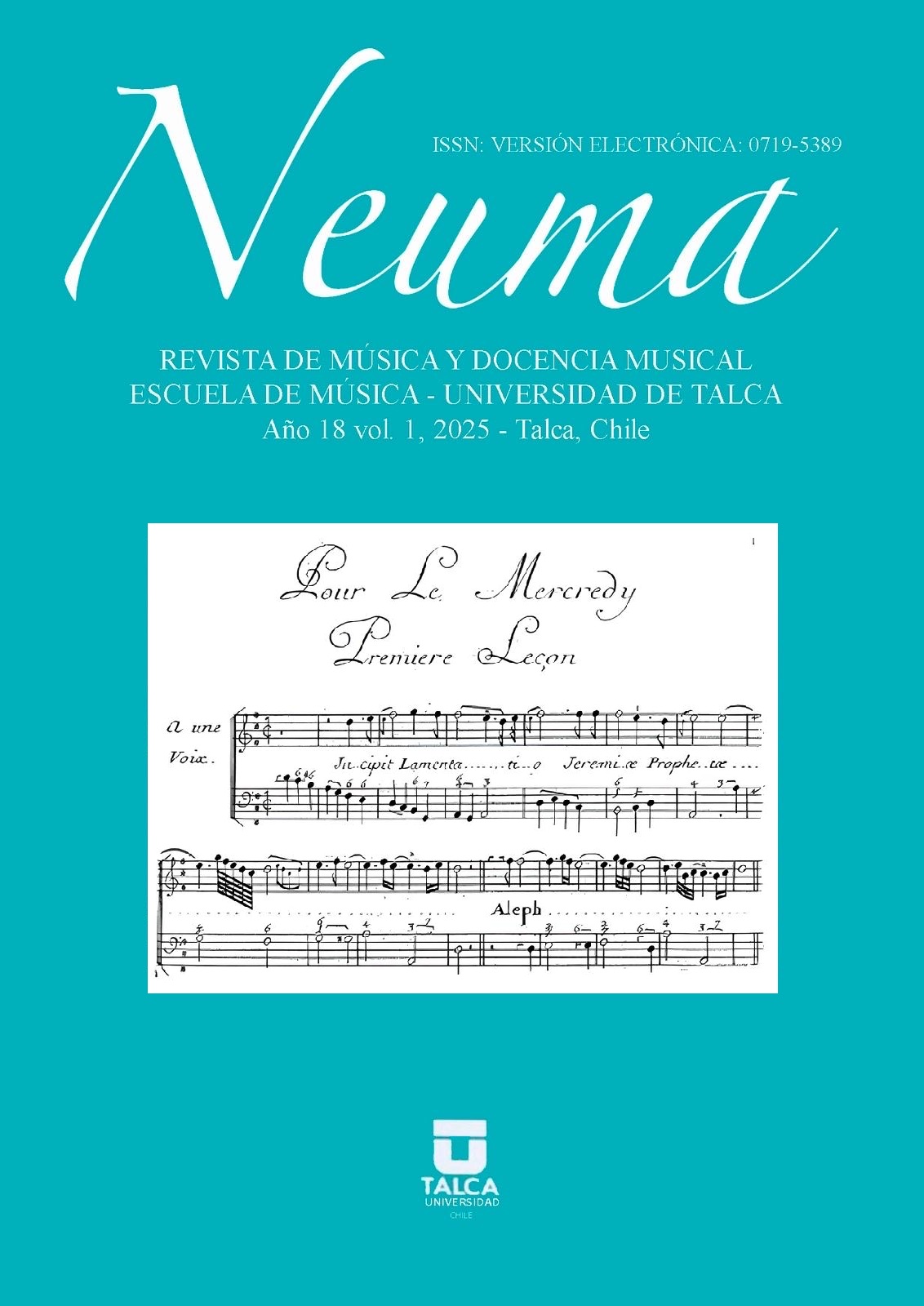Abstract
This exploratory and descriptive research and innovation in university teaching was carried out between August and December 2024 in theoretical-procedural subjects from 4 departments of the University of La Serena (ULS): Mathematics, Construction Engineering, Mechanical Engineering, and Music. Data was collected on students' perceptions regarding the implementation of a methodological innovation designed to enhance the teaching-learning process of theoretical-procedural content, which has the following objectives: 1) Increase the ability to remember and recognize elements and concepts in less time; 2) Improve the ability to solve theoretical-procedural problems in less time; 3) Develop the ability to integrate content and generalize concepts; 4) Enhance student commitment and autonomy. The initial stage of the research project, described in this article, focused on music theory. It laid the groundwork for a longer-term research proposal that will corroborate the usefulness and benefits of the proposed methodological innovation. This article presents the results obtained in the area of music theory teaching, where theoretical and procedural content from music literacy courses in the Bachelor of Music Program at the University of La Serena, Chile, was taught.
References
Anderson, Lorin W. y David R. Krathwohl (2001). A taxonomy for learning, teaching, and assessing: A revision of bloom’s taxonomy of educational objectives. New York: Longman.
Arievitch, Igor M. (2020). “The vision of Developmental Teaching and Learning and Bloom’s Taxonomy of educational objectives”, Learning, Culture and Social Interaction, 25, pp. 2-6. https://doi.org/10.1016/j.lcsi.2019.01.007
Biggs, John B. (2006). Calidad del aprendizaje universitario. Madrid: Narcea.
Biggs, John B. y Catherine So-kum Tang (2007). Teaching for quality learning at university: What the student does (3a ed.). Maidenhead: McGraw-Hill.
Broadbent, Jaclyn, Stefanie Sharman, Ernesto Panadero y Matthew Fuller-Tyszkiewicz (2021). “How does self-regulated learning influence formative assessment and summative grade? Comparing online and blended learners”. The Internet and Higher Education, 50, pp. 1-8. https://doi.org/10.1016/j.iheduc.2021.100805
Dekker, Truus (2007). “A Model for Constructing Classroom Assessments”. The Mathematics Teacher, 101(1), pp. 56–61.
De Lange, Jan (1999). Framework for classroom assessment in mathematics. Freudenthal Institute, National Center for Improving Student Learning and Achievement in Mathematics and Science. http://www.fi.uu.nl/publicaties/literatuur/6279.pdf
DeLotell, Pam, Loretta Millam y Michelle Reinhardt (2010). “The use of deep learning strategies in online business courses to impact student retention”. American Journal of Business Education, 3(12), pp. 49–55.
Endedijk, Maaike, Mieke Brekelmans, Peter Sleegers y Jan Vermunt (2016). “Measuring students’ self-regulated learning in professional education: Bridging the gap between event and aptitude measurements”. Quality and Quantity, 50(5), pp. 2141–2164. https://doi.org/10.1007/s11135-015-0255-4
Haji, Faizal, Rabia Khan, Glen Regehr, James Drake, Sandrine de Ribaupierre y Adam Dubrowski (2015). “Measuring cognitive load during simulation-based psychomotor skills training: Sensitivity of secondary-task performance and subjective ratings”. Advances in Health Sciences Education, 20(5), pp. 1237–1253. https://doi.org/10.1007/s10459-015-9599-8
Jamovi – Open Statistical Software (2025). Jamovi, version 2.6. https://www.jamovi.org
Judkins, Timothy, Dmitry Oleynikov y Nick Stergiou (2009). “Objective evaluation of expert and novice performance during robotic surgical training tasks”. Surgical Endoscopy, 23(3), pp. 590–597. https://doi.org/10.1007/s00464-008-9933-9
Labra-Godoy, Pamela, José Bustamante, Lukas Martínez, Patricia Iturrieta, Marcela Castro, Laura Guerrero, Angeline Rojas, Carlos Benti, Carlos Muñoz, Elizabeth Araya, Ana Aqueveque, Pilar Meneses, Manuel Cortés, Jaime Urquiza, Héctor Rivera y Fernanda Fabio (2016). “Aprendizaje en Educación Superior. Una mirada sistémica a los sujetos que aprenden, en un contexto de innovación curricular”. Revista Electrónica de Educación Superior, 1(1), pp. 39-65.
Moutsopoulou, Karolina, Qing Yang, Andrea Desantis y Florian Waszak (2014). “Stimulus–classification and stimulus–action associations: Effects of repetition learning and durability”. The Quarterly Journal of Experimental Psychology, 68(9), pp. 1744–1757. https://doi.org/10.1080/17470218.2014.984232
Moya, Emilio C. (2017). “Using active methodologies: The student?view”. Procedia-Social and Behavioral Sciences, 237, pp. 672–677. https://doi.org/10.1016/j.sbspro.2017.02.040
Ortega-Díaz, Cecilia y Antonio Hernández-Pérez (2015). Hacia el aprendizaje profundo en la reflexión de la práctica docente. Ra Ximhai, 11(4), pp. 213–220. https://www.redalyc.org/articulo.oa?id=46142596015
Pegalajar-Palomino, María C. (2020). “Relación entre la motivación académico-personal del estudiante novel en educación y las estrategias de trabajo autónomo”. Formación universitaria, 13(5), pp. 257–268. https://doi.org/10.4067/S0718-50062020000500257
Persky, Adam M. y Jennifer D. Robinson (2017). “Moving from novice to expertise and its implications for instruction”. American Journal of Pharmaceutical Education, 81(9), pp. 72-80. https://doi.org/10.5688/ajpe6065
Reagh, Zachariah M., Elizabeth A Murray y Michael A. Yassa (2017). “Repetition reveals ups and downs of hippocampal, thalamic, and neocortical engagement during mnemonic decisions”. Hippocampus, 27(2), pp. 1-27.
Silva, Juan y Daniela Maturana-Castillo (2017). “Una propuesta de modelo para introducir metodologías activas en educación superior”. Innovación educativa, 17(73), pp. 117–131. https://www.redalyc.org/journal/1794/179450594006/html/
Soto-Sánchez, Iván (2017). “Aprendizaje basado en preguntas y su impacto en las estrategias de aprendizaje en Física”. Enseñanza de las ciencias, (Num Extra), pp. 1903-1908.
Tamayo, Juan. M. y Juan Carlos Toapanta (2019). “La evaluación formativa: Interpretación y experiencias”. Mikarimin- Revista Científica Multidisciplinaria, 5(1), pp. 1-8. https://revista.uniandes.edu.ec/ojs/index.php/mikarimin/article/view/1269
Zhan, Lexia, Dingrong Guo, Gang Chen y Jiongjiong Yang (2018). “Effects of repetition learning on associative recognition over time: role of the hippocampus and prefrontal cortex”. Frontiers in Human Neuroscience, 12, 277. https://doi.org/10.3389/fnhum.2018.00277

This work is licensed under a Creative Commons Attribution-NonCommercial 4.0 International License.
Copyright (c) 2025 Neuma (Talca)


